|
|
|
|
|
|
|
|
|
|
|
|
|
|
 |
|
DOHENY EXPEDITION
MAIN REPORT
| THE Doheny Scientific Expedition left Los Angeles on the morning of
October 23d, 1924, by the Santa Fe Railway, for the El Tovar Hotel on the
rim of the Grand Canyon of the Colorado river in Northern Arizona.
Our destination was the Hava Supai Indian Reservation some 55 miles southwest
from the El Tovar Hotel.
We sent our mules on a day ahead to the Government warehouse at the head of the Tobocobe Trail leading into the Hava Supai Canyon. The next day we loaded a truck with supplies and camping equipment, and, overtaking the mules at noon, we arrived at the Supai village that same night. With an abundance of water and hay for our mules, we made this fertile little valley our headquarters during our investigations in this canyon. |
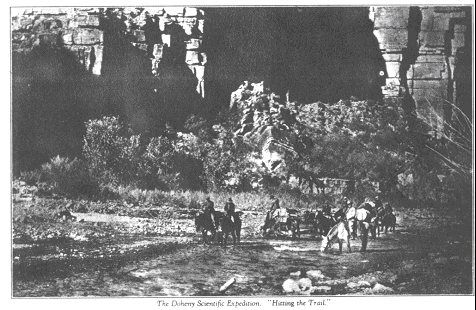 |

THE DINOSAUR PICTOGRAPH
The "Tobocobe Trail" after leaving the "Warehouse" at the Hill Top, makes its way for about six miles down Lee Canyon, a tributary canyon to the main canyon of the Supai. Just at the junction of these two canyons are the most important wall pictures so far discovered.
They are on a large wall of the lower red sandstone of the Carboniferous, and up some twenty feet or more from a bench on which some mesquite trees are growing. Some narrow ledges, about one foot wide, give access to these pictures, but in order to photograph them we found it necessary to pack some long timbers and some lumber from our camp six miles away.
We constructed a platform or parallel and with the assistance of this implement we were able to focus our cameras and secure good photographs.
Most of these pictographs are exposed to the weather without the suggestion
of a cave or an overhanging ledge. As they are all made in much the same
way one description will do for all of them.
HOW THE PICTOGRAPHS ARE MADE
The red sandstone contains a trace of iron. This iron, through the alchemy of unknown ages of time, forms a thin black scale on the surface of the stone, locally called the "Desert Varnish." By taking any sharp point, such as a piece of flint, and cutting through this black surface, the red stone is revealed underneath, thus making a picture, without the use of pigment, which is practically imperishable. The only way one of these pictographs can disappear is to weather off. They show every sign of a great antiquity, and in the thirty years they have been known to the writer there is not the slightest change noticeable.
The accompanying halftone, taken from a photograph made by Robert L. Carson of San Gabriel, California, gives a better idea of the figure than any description can possibly attempt to do. The fact that the animal is upright and balanced on its tail would seem to indicate that the prehistoric artist must have seen it alive.
That dinosaurs were in the vicinity, is proved by the tracks we dis-covered,
which were identified by Mr. Gilmore as belonging to one of the carnivorous
dinosaurs. These tracks were in the "Painted Desert" not over 100 miles
from the picture.

THE PARALLEL, used to photograph mall pictures (note Ibex near lower left hand corner). |
The dimensions of the figure are as follows: Total height 11.2 inches;
greatest width, 7 inches; length of leg, 3.8 inches; length of body, 3.9
inches; width of body, 3 inches; length of neck to top of curve, 3.5 inches;
length of tail (approximately) 9.1 inches; length of neck (approximately)
5.1 inches.
The under cut which outlined this figure was so deep that an excellent cast was made of it by J. F. Roop and Fred V. Shaw. The dimensions given above were made from this cast. On the same wall were a number of other figures of goat-like creatures, serpents, and unknown forms. The most remarkable of these was a row of symbols, deeply incised, which resembled the Greek sign of Mars showing shield and spear, thus. The "desert varnish" had commenced to form in the cut, indicating an unbelievable antiquity. About a year ago a photograph of the "dinosaur" was shown to a scientist of national repute, who was then specializing in dinosaurs. He said, "It is not a dinosaur, it is impossible, because we know that dinosaurs were extinct 12 million years before man appeared on earth." Kipling says in his poem "The Benefactors": "Ah what avails the classic bent,
If the reader agrees that this is a "dinosaur" then we are face to face with one of two conclusions. Either man goes back in Geologic time to the Triassic Period, which is millions of years beyond anything yet admitted, or else there were "left over" dinosaurs which came down into the age of mammals. Yet even this last conclusion indicates a vast antiquity. |
The next question is, what kind of a man? Was he a low-browed, big-jawed ape-like creature of small intelligence, the man who drew this picture a million or more years ago, or was he a being more after our own image?
Is it not true that this mute picture on the wall of this lonely canyon in far off Arizona is "like a voice calling in the wilderness," that is eloquent of many things.
It says "the man who drew me made and used tools. He had the patience
to chip an outline in hard stone with a crude flint and he had the perseverance
to finish the job. He had an eye for form and a sense of proportion. He
had the good judgment to select a medium which has preserved his work through
unguessed ages, almost untouched by the obliterating hand of Time. He posted
a warning to his fellows, 'beware of this creature, it is dangerous to
man'." He felt that same urge to create something, which links us to the
Gods. We submit, in the face of this evidence, that the "ape-man" (if there
ever has been such a creature), is buried still deeper in the overwhelming
ages of time.

THE DINOSAUR. Photograph by Robert L. Carson. Witnesses, Chas. W. Gilmore, Samuel Hubbard, J. F. Roop, Fred V. Shaw. |
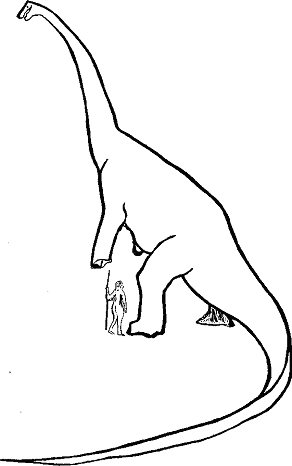
THE DIPLODOCUS. Restoration by Chas. R. Knight from a skeleton in American Museum of Natural History, New York City. (84 feet long, 12 feet 9 inches high). |
THE DINOSAUR TRACKS
Out on the edge of the "Painted Desert" we found dinosaur tracks We went by automobile from the El Tovar Hotel eastward through the Coconino forest Descending a long ridge we finally came to the Little Colorado river which we crossed on a fine suspension bridge. About eight miles this side of Tuba City we came to the tracks in the floor of the desert They were immediately identified by Mr. Gilmore as dinosaur footprints. More than that he pronounced them to be the tracks of a carnivorous dinosaur because the claw marks were plainly visible
The pink cliffs of the "Jura," with all their magnificent colouration,
were close by so it was easy to determine the formation as belonging to
the Triassic Period. The tracks were impressed in the sandy shore of what
had once been an ancient lake or sea, but the sand had long since turned
into stone. Three different species seemed to be represented, for there
were tracks of three individuals of different sizes.
| A cloud-burst had washed away the sand, exposing these tracks to view.
There was quite a large adjacent area still covered by a foot or more of
sand which doubtless contains more tracks.
The largest tracks were 16 inches long by 14 inches wide and 52 inches from heel to heel. Between two of the tracks were two hollow depressions which were thought to be where the end of the tail had touched in balancing the animal. We made plaster casts of the large tracks, made a moving picture of the casting process and took still pictures as well. It is significant that the dinosaur tracks were not over 100 miles from the dinosaur picture. |

Two views of Tracks of Carnivorous Dinosaur in "Painted Desert," Northern Arizona (note depressions made by tip of tail). |
THE ELEPHANT PICTURE
On the same wall with the dinosaur pictograph, and about 15 feet from
it we found a pictograph representing an animal which was evidently intended
for an elephant, attacking a large man. The elephant is striking the man
on the top of his head with its trunk. The wavy line represents water into
which the man has retreated up to his knees. Both arms are upraised and
the fingers are visible on one hand. The other hand holds something, the
form of which is too vague to be determined. Because there are no tusks
indicated our surmise is that it is a cow elephant.

Pictograph showing Elephant attacking large man. |
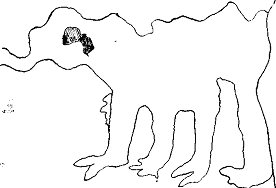
Line drawing of Elephant figure made in Hava Supai, Canyon by Samuel Hubbard May 5th, 1923 (about 1/2 actual size). The remains of elephants are very common all over North America and they are found from Alaska to Mexico. Three species are represented: the mammoth, the mastodon and the imperial elephant (elephas imperator) of California A complete skeleton of this latter animal was exhumed from the La Brea deposit in the city of Hollywood, and is now on exhibition in the Los Angeles museum. The remains of 28 individuals were found in one tar pit. The restored skeleton stands 14 feet high. |
We think it probable that the pictograph is intended to represent the California variety. It is apparent that if the man and the elephant are drawn to the same scale, the man is taller than the elephant. In other words the man is more than 14 feet high.
This prehistoric tragedy is significant of several things. Did the men of that day have a taste for elephant meat and prey on the elephant calves? The attack of an infuriated cow elephant whose baby has been slain, can be easily understood.
Dr. Frederick A. Lucas, Director of the American Museum of Natural History,
in his book on "Animals of the Past," states that while he believes man
and the elephant were coeval in America, yet there is no record so far
produced that proves this beyond a reasonable doubt.
Here, on this canyon wall, some prehistoric man has not only drawn
an elephant, but he has drawn an elephant attacking a man. We submit this
drawing as confirming Dr. Lucas' belief and proving the case.
There is no means by which we can tell whether the elephant was drawn before or after the dinosaur.
The dinosaur figure is cut into the sandstone much more deeply than the elephant. It was possible to make a good plaster cast of the dinosaur, but not possible to cast the elephant. Our surmise is that the two figures were made by different people and at different times and in a slightly different way. As stated before, the symbols near the dinosaur figure in which the "desert varnish" has formed in the cut, have a character all their own, and probably in point of time, precede all the others.
The elephant figure measures approximately 7.5 inches high, and 10.3
inches long, not including the trunk. The man's figure from the knees to
the top of the head is about 7 inches high.
THE IBEX
In three different places in this canyon we found ibex pictured on the one group showing a male and two females, was right under the elephant picture, but close to the ground. These showed the effects of and were quite indistinct. The next in importance was a beautiful panel about a mile up Lee Canyon from its junction with the main Supai Canyon. This was a smooth face of red sandstone on the side of a huge boulder.
There was no black surface on this stone so the figures were beautifully
carved, about a quarter of an inch deep. This whole panel showed
a very high type of workmanship and was quite different from the cruder
work just described. In order that there might be no mistake about
it, mountain sheep were shown on the same panel with the ibex.

Head of Arabian Ibex, (capra Nubiana). These true goats, represented by several species, are found in the Pyrenees, in the Alps, the Carpathians; in Northern Africa, in Mesopotamia, in the Himalayas and in the Altai Mountains in Asia. They have never been known in America. |
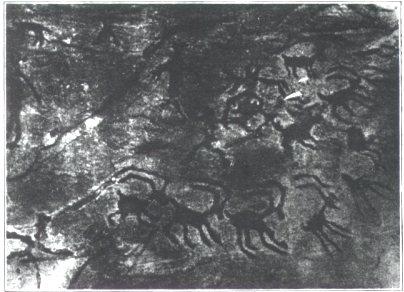
Detail from Ibex Panel in Lee Canyon. Ibex and Deer being driven into a trap or up a pass.
|
| The scene represented seems to show several hunters driving seven ibex
and two deer into a trap or up a pass. Roy Chapman Anderws, who has
hunted ibex in the Gobi Desert in Mongolia, pronounced these to be ibex
for the reason that the characteristic knobs on the front of the horns
are faithfully represented in the carving.
The interesting thing about this is, that no ibex, not even fossil ones, have ever been found in America. These drawings would seem to indicate that they must have been a common animal in the Grand Canyon region, in the prehistoric past. In a cave near Alpera, in Spain, there are drawings representing people
like American Indians, hunting ibex with bow and arrow From Spain to Arizona
is a far cry "—(see Illustrated London News of Dec. 20th, 1919).
|

Pictograph of Ibex showing one male and two females (located beneath Elephant and Dinosaur pictures). |
THE "COUDA-PAH"
In the Supai language the word "Couda-pahvich," freely translated means big Indian long time dead." The abbreviated word "Couda-pah" means any prehistoric picture, track or relic belonging to the Past The longer ago it was the longer they accent the word "Couda "
About a half mile down the main Supai Canyon from the wall pictures just described, there is a mysterious stone figure embedded into the walls of the canyon. The Indians claim this was once a living woman whose body was turned into stone by the action of the lime in the water. Beside her lies her baby, wrapped in skins, also solid stone.
The body is about 60 feet straight up from the present floor of the canyon, and can only be closely examined by making a long detour through a side canyon. This gives access to a table of rock above the body. From this point a descent, involving considerable risk, must be made to the figure by means of a rope ladder. From the body down to the stream bed, the wall is perpendicular, so that a mishap here would be serious.
The figure lies face downward, with arms extended, therefore no features are visible. The object is in a sort of a flat crevice with an overhanging roof. This has protected it somewhat from the weather and from falling rocks. It has weathered to a shiny black color. As it is pure limestone, bedded into red sandstone without a sign of a joint, this precludes any suggestion of a carving.
Owing to the danger involved, and to the overhanging crevice which leaves the figure in the shade, it is not possible to make a satisfactory photograph, so none is offered here.
Mr. Gilmore made a hasty examination of the figure and believed it to be an aggregation of limestone in the form of a human being. He admitted however, that there were some points in favor of the belief of the Indians.
The head is somewhat flattened, but the back, thighs, buttocks and a fragment of the forearm are very much like a human being. The body measures five and one-half feet from the top of the head to the end of the spine, involving a total height of between eleven and twelve feet.
While it is quite true that Nature makes many freaks, resembling all
sorts of things, yet we feel there is enough doubt in this whole matter
to warrant a more complete examination by a party prepared to spend the
necessary time.
THE ANCIENT FORTRESS
Out on that part of the plateau known as "The Thumb," a huge slab of limestone has slipped away from the main wall and stands like an isolated "island of stone," on the very brink of the Grand Canyon.
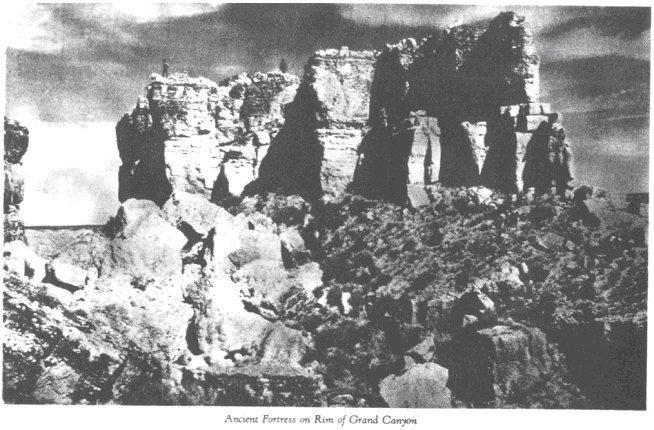
There is a steep sided gully between it and the main wall, and by worming up a crevice an active man may reach the top. It is a good bowshot from the shore of this island to the main land, but on the other side there is a sickening drop of some 3000 feet straight down to the inner gorge of the Colorado.
On the side toward the gully, a low wall of cyclopean blocks of stone has been constructed. How those immense blocks of stone were hoisted up there is a mystery. The whole refuge is not over 200 feet long by 50 or 60 feet wide. It was evidently a place of last resort from which there was no escape.
Whatever heroic deeds have been done here will never be known, for the
present Indians have never used it, and know practically nothing about
it. Mr. Gilmore picked up an arrow-point and some shards of pottery on
the top of this fortress. These were identified in Washington as belonging
to a pre-Pueblo culture and were evidently very ancient.
CONCLUSION
In conclusion we would like to point out that there are miles upon miles of this Grand Canyon region which no white man has ever seen. We have found enough to convince us that it is a veritable mine of archaeological treasures. There is enough in sight now to keep a party going for several seasons.
Not far from this "Fortress," in the main Grand Canyon we found some "tracks" which even Mr. Gilmore himself was at a loss to explain. They were either in the red sandstone of the Carboniferous, where such tracks are not supposed to be, or they were impressed in the mud of a river channel at a later date. The Colorado river was at this level when the tracks were made. Since then it has kept on about its business and cut its gorge some 2500 feet deeper.
The lapse of time as shown in this canyon is so tremendous that it is simply overwhelming. It makes our little year of 365 days seem trifling. Has not the time arrived when we must devise a new "unit of measure" to block off these great "Periods of the Past?" Must we not readjust many of our ideas regarding the antiquity of man, and his contact with the prehistoric animals, which have gone, to return no more?
Perhaps if we can find out where we came from and what we came from,
it may help us to get a little glimpse ahead along the "Trail of Life"
we are now so painfully following. It may help us to solve the great riddle
of the Universe: "Where do we go from here?"
REPORT OF ATKIN & McRAE
ASSAYERS, CHEMISTS AND METALLURGISTS
Los ANGELES, CALIF., Dec, 10, 1924.
Mr. Howard Throckmorton, Los Angeles, Calif.
Dear Sir:
Following is result of analyses of samples of water submitted:
| Supai River | Supai Well | |
| Sodium Chloride (NaCl) | 0.5 | 41.6 grains per gallon |
| Magnesium Chloride (MgCl2) | 4.9 | |
| Calcium Sulfate (CaSO4) | 7.5 | 20.1 |
| Magnesium Sulfate (MgSO4) | 6.4 | |
| Calcium Carbonate (CaCO3) | 17.0 | |
| Magnesium Carbonate (MgCO3) | 8.5 | 65.0 |
| Total | 38.4 | 133.1 |
| Actual total solids by evaporation | 41.2 | 136.8 |
It is evident from above analyses that the river water is much purer than well water, in fact former would be considered fairly good drinking water.
You will note that the actual total solids, compare with total of determined results, showing that, even with small amount of water submitted, we were able to obtain fairly accurate results.
|
|
|
|
|
|
|